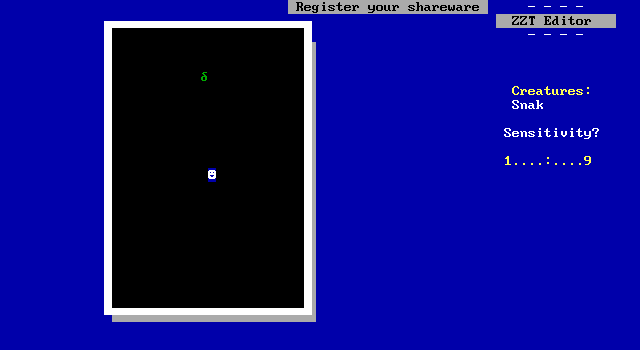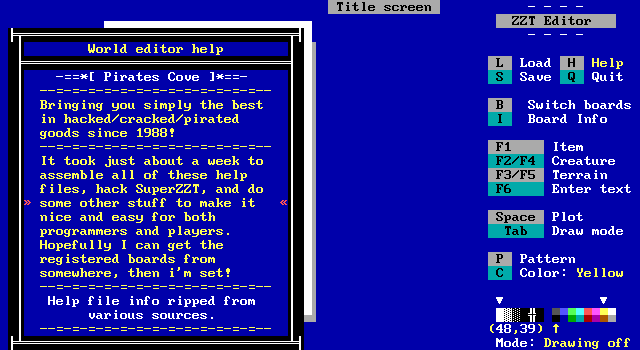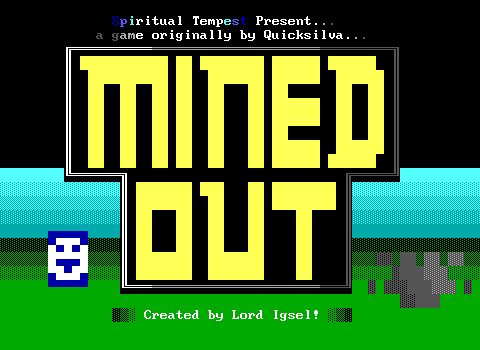Alright... let's do this one. Most of today's update has been sitting in the queue since February!
And the reason for that is that these files aren't ZZT worlds, but long forgotten ZZT clones that have been dug. (By asie, surprise.) They also tend to be really finicky to run. Despite having memory of running the EZZT games back in the day my attempts to run them on some vintage hardware also failed and when it got to the point of "If I'm going to try Windows 95 I need to open up this computer and put in an older video card that supports the OS" and that's when I officially gave up on running them myself.
Of course asie has managed to get them all going and thankfully recorded some video of them so they're going to get a little bit of love at least.
“ZZT Enhancer 0.3 Beta” by Craig Boston (1998)
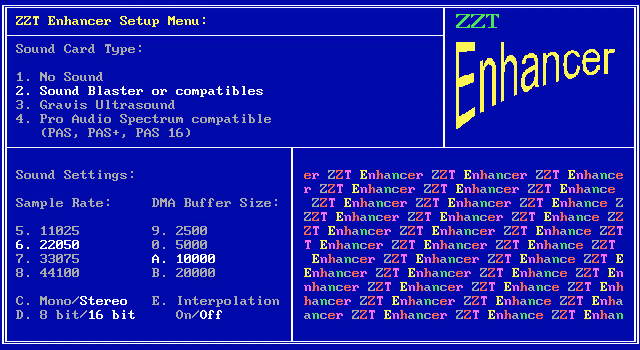
Program Description
Runtime patching hooks-based enhancement program for ZZT with custom ZZT-OOP extensions and audio/resource support.
Firstly, the "clone" itself. ZZT Enhancer or EZZT as it's abbreviated isn't actually a ZZT clone in the traditional sense. It is a program that still requires a copy of ZZT. EZZT on its own won't do anything ZZT doesn't as it requires specific EZZT designed games and data to be able to do anything.
Both EZZT and the two worlds that show off what it can do were uploaded to a Google hosted site in 2010 that's still up today.
“ZZT Enhancer - Caverns for ZZT” by Craig Boston, Mark McIntyre (1998)
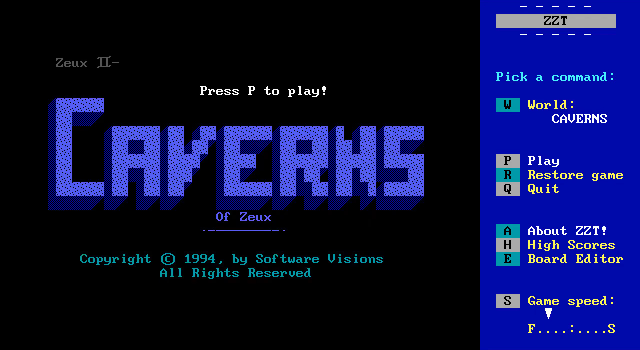
So what is EZZT exactly? Well, here's a conversion of the opening portion of MegaZeux's first world: Caverns of Zeux.
And hey, it doesn't look half bad! Proper charset, a sweet mix of Janson's CV_MAGIC.MOD, and a detailed HUD modified to not only adjust ZZT's counters but add new ones used in Caverns as well. It's got screen shakes, its got explosions, it's got ice physics! Yet it's still very ZZT in its own way. The boards are still the usual 60x25 size and you can still find objects hiding in the corners of a lot of boards hinting at where game specific code is being stored.
EZZT hooks directly into ZZT itself using virtual 8086 mode to to elevate ZZT into a far more advanced form. For most of the video this looks like a tool to add more powerful functionality to ZZT, but then towards the end (7:37) the spell book interface is shown and suddenly things stop being ASCII entirely as a fully graphical interface is displayed!
“ZZT Enhancer - Evil3” by Craig Boston (1998)
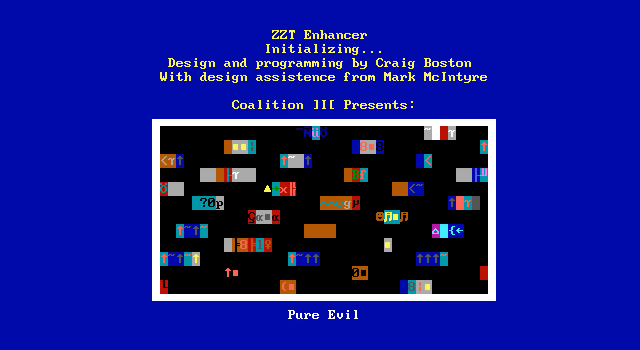
Pure Evil meanwhile is an EZZT world that's less tech demo and more test suite. This starts with a focus on MegaZeux style items which on its own begs the question of why not just use MegaZeux, but things like the spell book interface in EZZT's Caverns show that MZX-style elements are just the beginning. It also makes sense to focus so much on implementing MegaZeux's built-ins as its own creation comes from "ZZT can't do this" which thanks to EZZT, it now can.
The demonstration goes on to include things like a side-view board in which the player has a jump key. Unlike most (but not all) ZZT platformers the player isn't hitting buttons to make an object do the platforming, but the player can finally be adapted to more versatile roles.
Other showcased features include objects that keep their background color when moving, bombs that can detonate other bombs, changing the player's appearance, and locking the player's movement with the ability to have an object forcibly move them.
At this time no source code is known to exist nor tools for editing. EZZT was a clever idea in its day that would have eventually run into issues as support for DOS programs was slowly phased out for Windows. It also seems to have no documentation so even when it was contemporary others couldn't really make use of the program to create their own enhanced worlds.
It's a cool historical piece that no doubt turned a few heads to see Caverns and I'm sure a young me was more excited for this when dealing with weird memory errors in MegaZeux at the time. In the grand scheme it never really stood a chance in its current state where the files that hold all the enhancements are directly tied to specific ZZT files. Nobody was actually able to use these existing hooks to make their own enhanced ZZT worlds. That and without any publicly available tools known to have existed make it unlikely that there ever were any other EZZT creations beyond these two worlds.
“Corndog (Project Dump)” by Darren Hewer (1999)

Next we have a project dump of Corndog, the best named ZZT clone ever. There's a bit of source code here written in Euphoria. The biggest part of this upload is the text file which contains documentation and plans for Corndog's "Doggerel" language. There's plenty here for string handling and a good amount of functionality you'll find in MegaZeux's Robotic language.
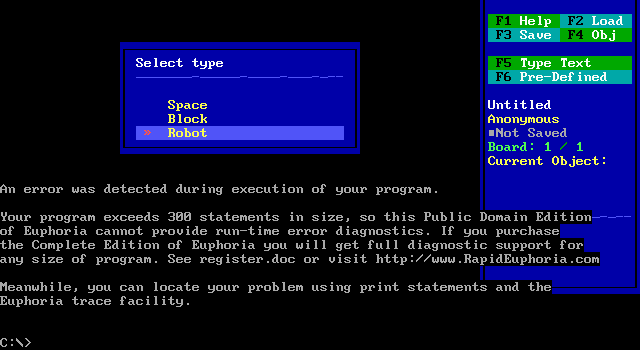
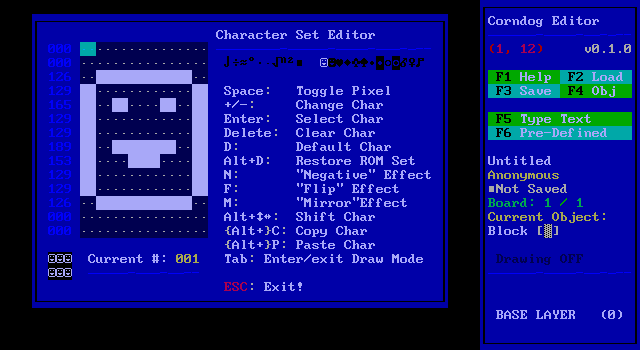
“Z2 v0.61 Beta (Incomplete)” by Carlos DaSilva (1996)
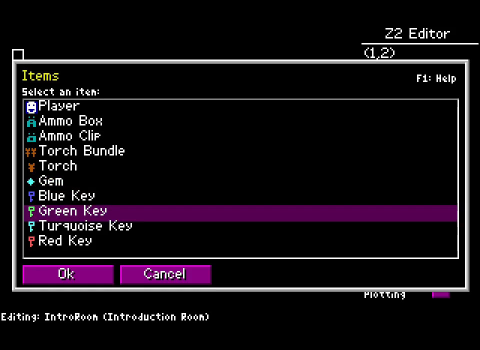
Program Description
ZZT clone/successor attempt
Z2 is one of the earliest ZZT successors known only to be predated by MegaZeux and Super ZZT. This long lost copy is unfortunately missing some critical files such as its font, though asie has again done a video with an arbitrary one to show off what's there.
Z2 is of course noteworthy for sharing a name with the successor site to the original ZZT archive. The name for the clone has its own story behind it as well. Reportedly DaSilva asked Tim Sweeney if he could make "ZZT 2" and had Sweeney tell him he could absolutely make whatever he liked, but to please not call it that. ZZT™. (The TM stands for "TiM's game".)
Sadly, there's more missing than just a font. Z2 is intended to have a "Global Room" that can be populated with elements and code to be used throughout the game. Additionally there's a "System Room" which handles what in ZZT would be the built-in elements. The file that contains the system room's code is lost which means that everything has to be programmed from nothing. Plenty of documentation is included if you're willing to put in the effort although many commands don't seem to be implemented yet.
“Super ZZT (Cracked)” by Pirates Cove, Tim Sweeney (1996)
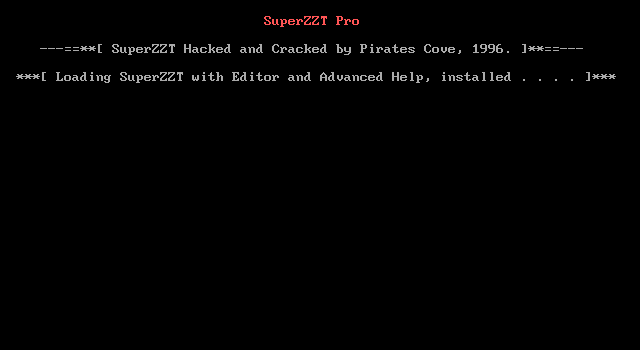
Finally, we have a new discovery that was a very unexpected surprise. A clone this ain't. This is a cracked copy of Super ZZT.
How pointless is it? Incredibly. Yet there's a surprising amount of effort here.
The obvious question is what's even "cracked" about it. Like ZZT, Super ZZT doesn't limit its functionality in the shareware versions. The only thing the user gets via registration are the registered worlds. So what's changed here is that a "REGISTER.DOC" file is included to make Super ZZT think it's registered and display its ability to open the world list from the main screen. Then there's a SUPERZZT.COM file which is intended to be used to run the program. This will display a message prior to launching the program crediting the crack and automatically pass the /e argument needed to unlock access to the editor. The same credits are repeated when the program closes as well. Lastly and quite surprisingly is a whole bunch of cobbled together help files to document how to use the editor, something Super ZZT never officially had. These documents are credited as being compiled from various sources and formatted to fit the message windows in Super ZZT.
Finally, the executable itself is slightly adjusted. The editor HUD is updated to list some of the undocumented menus and most importantly of all, within the editor "Bear" is now "Snak" to reflect the change that bears underwent in Super ZZT to become Snakes (despite internally and in ZZT-OOP still being called bears).
The registered worlds aren't included here which makes this crack quite the oddity. This could have just as well been released as a fan-edit to make the editor more readily accessible and provide documentation, but the framing of it as some forbidden pirated copy of the game would only mean that most sites would be too reluctant to host a copy.

